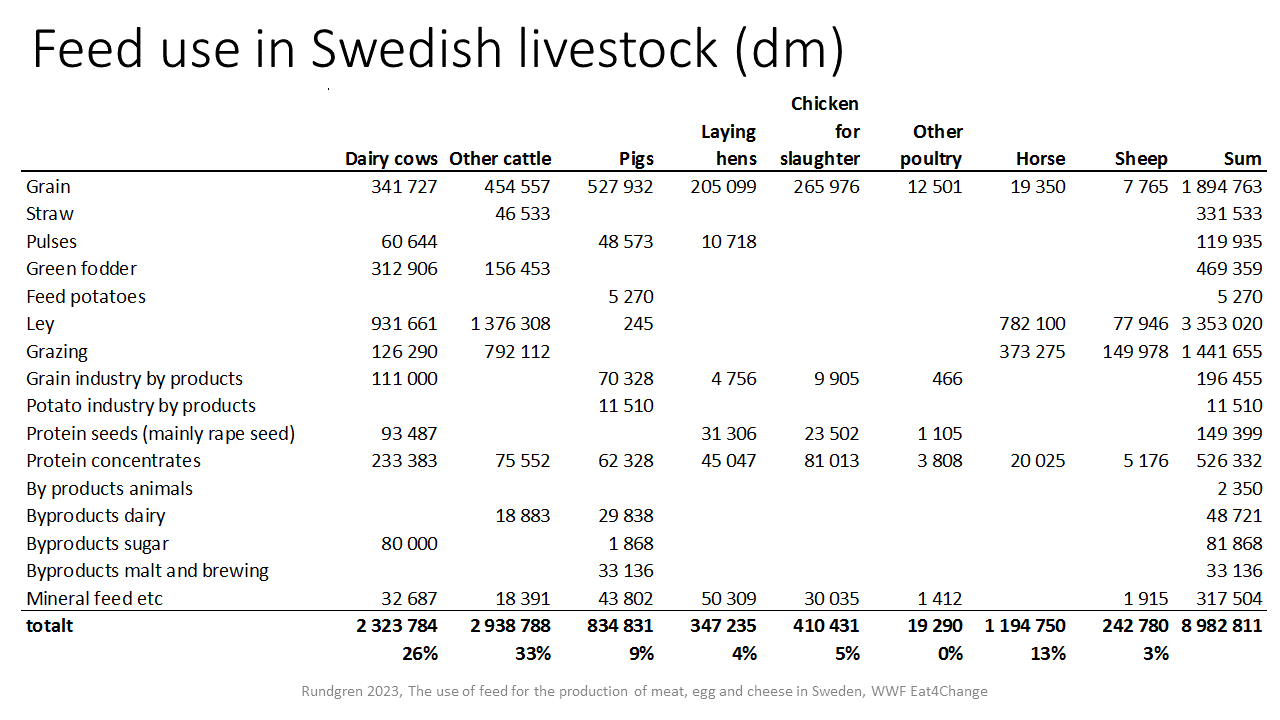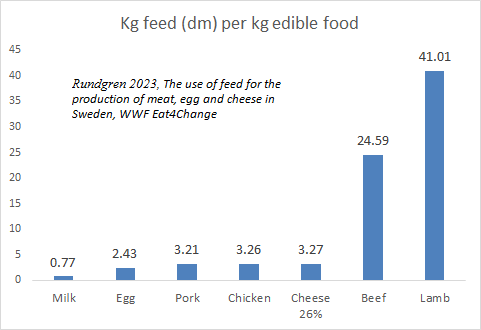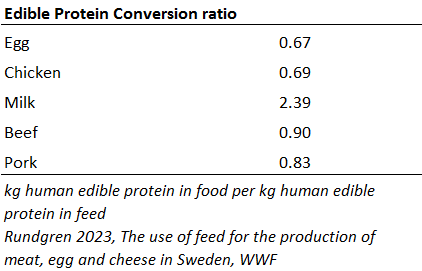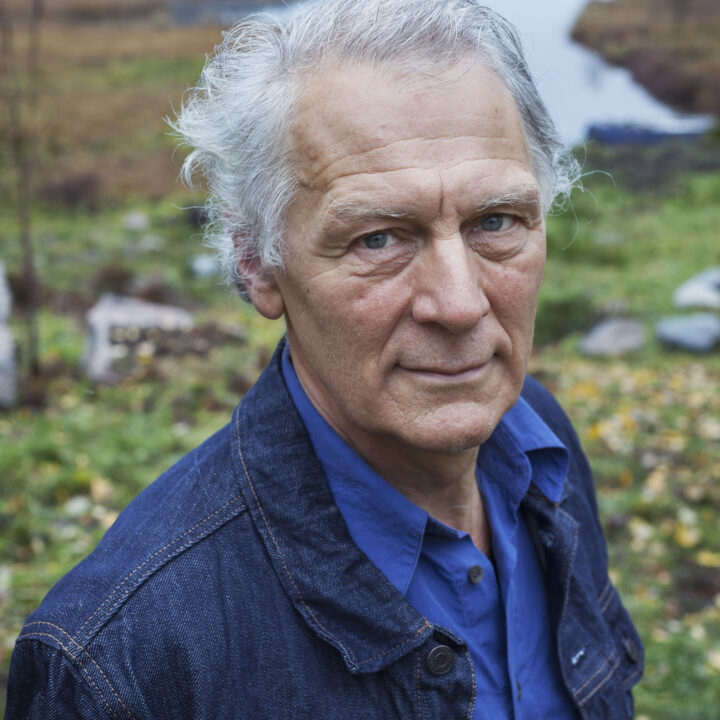Several days ago I presented a report on the feed use in Swedish livestock production which I made for the WWF. *
Feed use in livestock production is central from a number of perspectives. Livestock converts feeds into various products (meat, milk, hides and hundreds of other products) and services (from drought power to ecosystem function and company) for humanity. Feed production or grazing also constitute a major share of the costs for livestock production. Feed production and animal metabolism are also major causes of environmental impact. Approximately 55% of the Swedish arable crop is dedicated to animal feed. .
The study documents and analyses data regarding the feed composition and the amount of feed, expressed in dry matter (dm), used for the following Swedish (produced in Sweden, and made from animals raised in Sweden) animal-based products: 1 kg of human edible meat of pork, chicken, lamb, beef, 1 kg of cheese and 1 kg of egg without shell. In addition to this, the conversion of human edible protein** is also calculated.
The calculated feed use is supposed to reflect the average Swedish commercial production, based on feed rations supplied by industry sources or independent research. Consideration is taken of factors that impact feed use, such as mortality, variations in age at slaughter, variations in breeding systems and races. The calculations also include feed to the parent animals and recruitment animals. The calculated feed rations were compared with data from the feed industry, total crop harvest, estimates of waste and loss, statistics for the use of grain, trade statistics and other research and adjusted if there were major differences. Actual feed use is mostly considerably higher than theoretical feed rations, which are based on optimal conditions.

Apart from clarifying the feed used, the study also elaborates on how big share of the animal that is edible, i.e. used for human food consumption. Feed use efficiency reports from the livestock industry has normally expressed the feed use per kg live weight, while feed use calculations in life cycle assessments mostly focus on carcass weight or boneless meat. But the whole carcass is not eaten, primarily not the bones, and there are parts of the animal that are not part of the carcass weight (organs, fat and some meat) which are edible. Human edible is defined as products which are eaten as food or processed into food (sausages etc.) in Sweden or exported to markets where they are consumed as food (e.g. pig feet, chicken wings). In addition, potentially edible meat has also been calculated, including parts of the animal which are not eaten in Sweden or exported as human food, but could be eaten. The difference between human edible and potentially edible indicates the potential for increasing the valorisation of a bigger part of the animal as human food. This potential is biggest for beef followed by chicken. It is clearly a low-hanging fruit when it comes to lower the ecological footprint of livestock production if a bigger part of the animal is actually consumed.

Milk has the lowest feed use of the studied products, 0.77 kg of feed is used to produce 1kg of milk. Even calculated on a dry matter basis it still use less feed than egg production, which otherwise has a low use of feed. For the meats, the feed use per kg edible meat is lowest, and almost the same, for chicken and pork. This is perhaps surprising as feed conversion of chicken is mostly said to be superior of other animals. The reason for this is that feed conversion is mostly measured against live weight while the share of a pig that is edible is higher than of a chicken.
Cattle and sheep have very high feed use. This is a result of the digestive system of ruminants. While consuming a lot, they also have the ability to digest feed which is too coarse for the monogastric animals, pigs and hens. This also results in that they use less human edible protein to produce human edible protein in the form of animal products. The monogastric animals use feed protein that is more easily digested. Milk has the highest ratio of 2.4 kg of human edible protein for each kg of edible protein used as feed.

For many, these figures are a clear indication of that livestock production in general, with the exception of milk production, is wasteful. But that is an unwarranted jump to conclusion. Notably, the calculation of protein conversion has not taken into account the higher nutritional value of animal proteins compared to the protein in their feed. It has also not considered other nutrients for which animal products are important. It is also not clear how efficient a plant based food system without livestock would be. Many by-products which now can be transformed into high-quality food may not find any reasonable use in such a system. That is for example the case with most oil seed meals and second grade quality of grain.
Still, the figures tell us something.
In general, animals in rich countries have been converted into consumers of high quality feed instead of being efficient transformers of things humans cannot eat. This is of course most apparent with pets and horses, which don’t produce almost any food (some horse meat is consumed in some countries and in other horse meat is illegally sold as beef, remember the horse lasagne scandal?). Horses consume 13% of all feed in Sweden an equal quantity as pigs and hens together.
The overproduction of grain and oil seeds in the world, mainly driven by artificial fertilizers, has made it cheap and “efficient” to feed animals with grain and oil seed cakes (predominantly soy). Even feed that is more or less “for free” can’t compete with that. Farmers in Sweden have abandoned 90 percent of the semi-natural grasslands despite the fact that the grass grows without fertilizers or irrigation. It is simply more profitable to raise beef cattle in feedlots style indoors. The cost of fencing, movement of animals, daily oversight and provision pf drinking water is higher than having animals confined and fed with harvested feed. The abandonment of semi-natural grasslands is meanwhile one of the biggest threat to bio-diversity in the country. The overproduction of grain also led to a huge expansion of the production – and consumption – of chicken and pigs, in Sweden and globally, as chicken and pigs are much better converters of grain and soy than cattle.
When farming was still coupled to and dependent of local ecosystems, people and landscapes, the primary role of livestock was to utilize ecological niches in the landscape and human society without eating things that human could eat to any large extent. Cattle, sheep, camels, goats and other herbivores ate grass, leaves, shrubs and crop residues (straw, chaff etc.). They provided multiple services apart from milk and meat; drought power, skin and leather, wool, hair, storage of wealth and much more. Pigs, hens and other poultry got scraps and fed themselves close to the farm on manure heaps, cropped fields and whatever was available. Commercial chicken production didn’t exist at all. The role of livestock differed quite a lot from purely pastoralist systems without any arable farming to very intensive plant based systems with a very low share of livestock. Most systems still had a considerable share of animals. This was certainly the case in Sweden which had the same number of cattle 1870 as today while the population has increased with more than 150 percent.
Ruminants that eat predominantly grass will have an “indefinite” protein conversion ratio as virtually no human edible protein is used. We have a small herd of five mother cows which are only fed grass and small quantities of leftovers from our vegetable production and – I must admit – they share a 20 kg bag of concentrate feed among themselves at calving. From them, or rather their offspring, we get some 750 kg of meat every year. Again and again it is demonstrated that grass based ruminant farming, in most cases, despite a very high feed use and land use, is simply one of the most sustainable farming systems there are. Having said that, there are agro-ecosystems where other livestock may play a bigger role. Pigs have played a big role in traditional agriculture in many parts of Asia and the Pacific.
In a coming article I will discuss some other findings in my report.
* The full report can be downloaded here: use-of-feed-for-the-production-of-meat-egg-and-cheese-in-sweden-final.pdf (wwf.se) and the supplement: supplement_use-of-feed-for-the-production-of-meat-egg-and-cheese-in-sweden_gunnar-rundgren.xlsx (live.com)
** ”Human edible” in the context of the report is defined as protein that ís actually consumed by humans, not theoretically edible. This means that part of the animal that are not normally eaten will not be considered human edible and that the share of a plant that is human edible is based on the actual consumption (i.e. most wheat is consumerd as white flour and the bran is used as animal feed, which means that most of the bran is not included in ”human edible”.






